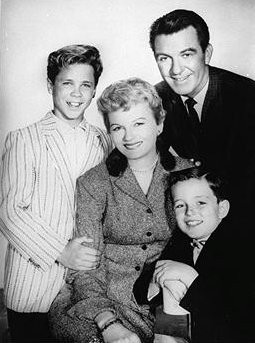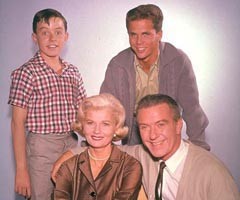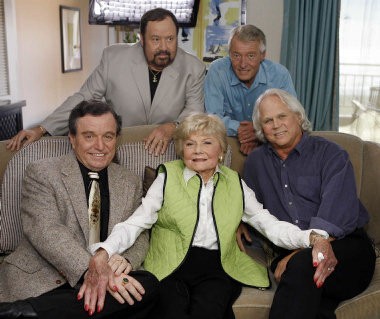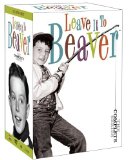| Reviews & Columns |
|
Reviews DVD TV on DVD Blu-ray 4K UHD International DVDs In Theaters Reviews by Studio Video Games Features Collector Series DVDs Easter Egg Database Interviews DVD Talk Radio Feature Articles Columns Anime Talk DVD Savant Horror DVDs The M.O.D. Squad Art House HD Talk Silent DVD
|
DVD Talk Forum |
|
|
| Resources |
|
DVD Price Search Customer Service #'s RCE Info Links |
|
Columns
|
|
|
Leave It To Beaver - The Complete Series
And yet as criticized as it was, it's always somewhere on the airwaves, even after television stations stopped showing old black & white TV shows and movies to make way for all those mind-numbing infomercials. Beaver somehow never lost its audience and it remained popular. But the shared affection toward Leave It to Beaver differs from other familiar, forever-syndicated programs like The Brady Bunch, a series remembered more because it was drummed into the collective consciousnesses of the '70s generation through endless UHF repeats rather than because it was any good. No, Leave It to Beaver is remembered because was an extremely well-made, memorable show. As writer-producer Brian Levant remarks in one of the featurettes, Leave It to Beaver was almost unique among American sitcoms - it was wise.
Like most audiences, until recently I took Leave It to Beaver for granted. But then something in Vince Waldron's excellent The Dick Van Dyke Show Book got me thinking about the series in a new way. Waldron quotes Dick Van Dyke Show creator Carl Reiner, who expresses an unreserved admiration for the series, and who talks about how it influenced his own famous sitcom, a series now regarded as one of the three or four best television comedies of all-time.
While The Dick Van Dyke Show, about the home and work life of a comedy-variety television show writer, and Beaver, about two brothers and their relationship with their suburban middle-class parents, their friends and community, have entirely different agendas, they took the same basic approach. Their scripts slightly expanded into comic terms real-life incidents, authentic little slices of life that, in Beaver's case, captured the essence of youth.
Shout! Factory's Leave It to Beaver - The Complete Series, is a terrific package that includes all 234 episodes of the 1957-1963 show, with six 6-disc season sets neatly packed into brick-sized cardboard packaging, along with a bonus disc supplementing the mostly radio interview extras interspersed throughout the six seasons. Shout! Factory sublicensed the series from Universal but unlike earlier, disappointing transfers of Shout!/Universal titles (e.g., McHale's Navy), these remastered shows look spectacular. All told this set includes nearly 100 hours worth of material.
At the beginning and near the end.
As hardly needs explaining, Leave It to Beaver is a half-hour situation comedy focusing on the boyhood (and, later, the tumultuous teenage) trials and tribulations of Theodore "Beaver" Cleaver (Jerry Mathers) and his older brother Wally (Tony Dow), who live in a pleasant, middle class suburban home with their parents, Ward (Hugh Beaumont) and June (top-billed Barbara Billingsley).
Created by Joe Connelly and Bob Mosher, who before this were writers on The Amos 'n Andy Show and who later wrote and produced The Munsters, Leave It to Beaver was ingeniously simple. Instead of a family sitcom told from a neutral, third-person perspective or which functioned mainly as a vehicle for its adult star, Leave It to Beaver told its stories entirely from Beaver and/or Wally's perspective - there are no shows pivoting around Ward and/or June's concerns. Indeed, the audience never even sees their bedroom during the entire run of the show.
The problems and challenges Beaver and Wally face might seem trivial or inane to adults, but Connelly and Mosher obviously remembered how monumentally important they could be to children and teenagers. One entire episode revolves around Beaver's stubborn determination not to dress-up for an awards banquet, another around Beaver's regret and embarrassment after he makes a funny face for a class picture. In another show Wally baby-sits Beaver who accidentally lets the bathtub overflow, which in turn seriously damages the plaster ceiling in the kitchen below. They successfully hide the disaster, but then Wally feels horribly guilty after Ward praises him for having been so responsible.
Ward and June are sweetly sensitive and understanding, but not really idealized. Ward is often (mildly) irritable while June tends to be fussy and overly protective of her children. Sometimes, they also - gasp! - actually make mistakes that create major problems for the boys, like when Wally runs for class president and Ward's terrible advice costs his son the election, or when Ward unthinkingly tosses out a book Beaver had proudly given him to help with the family's finances. Though not emphasized, Ward sometimes mentions to June that his sensitive handling of the boys is a direct response to the mistakes made by his own taskmaster father. In one episode Beaver runs away from home after being scolded for drilling holes in the family garage. Ward decides to teach him a lesson by letting Beaver run away and only later does Ward realize his mistake. His father did the same thing, and that made Ward feel pretty lousy. The regret in Beaumont's performance is beautifully and sincerely expressed here.
The idea of parents who don't have all the answers, who occasionally make mistakes, admit them and even apologize to their children isn't just unusual, but downright revolutionary in 1950s terms.
While things never get too serious, Leave It to Beaver sometimes honestly touched upon surprisingly topics, often revolving around adults who disappoint them, like the adult friend of Wally and Beaver who is revealed to be an alcoholic, or their own Uncle Billy (Edgar Buchanan), a colorful but irresponsible character that unwittingly hurts the boys' feelings in several shows.
The casting is perfect. Mathers had been a naturally funny child star for a few years, most famously in Alfred Hitchcock's The Trouble with Harry (1955), and his characterization, awkward and naïve but kind-hearted, has real verisimilitude. Not surprisingly, cast members recall Mathers's amazing ability as a child performer, that he had a knack for nailing dialogue perfectly, usually on a first take, always coming off like a little boy speaking extemporaneously, never a child actor reading lines written by adults.
Tony Dow was less naturally talented but in some ways is even more believable as the somewhat more responsible eldest son. Both Hugh Beaumont and Barbara Billingsley had unremarkable careers before this. Billingsley had uncredited bit roles in major movies going back to 1945 and small roles in B-movies like Invaders from Mars (1953), while Beaumont, who also later became one of Beaver's regular directors, similarly bounced between bits in big movies and larger roles in small ones, including a stint as Michael Shayne.* Beaumont gives an especially amusing performance throughout the series, subtly revealing an acerbic sense of humor.
Probably the one character everyone remembers from Leave It to Beaver is Wally's rakish pal Eddie Haskell (Ken Osmond), whose slippery veneer of politeness cannot mask his wise guy ways. The character and Osmond's amusing performance are priceless.
Eddie Haskell wasn't the show's only villain. Despite a reputation for idealizing '50s Americana, Leave It to Beaver was crowded with devious, self-involved, gluttonous, and destructive children and teenagers worthy of Roald Dahl. Wally and Eddie's pal Clarence "Lumpy" Rutherford (Frank Bank) was a fat, dumb, reformed bully and, if anything, Beaver's pals were even worse: among them the genuinely irritating Gilbert Bates (Stephen Talbot, whose very voice is like fingernails on a blackboard) and contemptible Larry Mondello (Rusty Stevens), who was always talking Beaver into things he wanted, and against the Beav's better judgment.**
Their parents were also anti-role models. Larry's mother (Madge Blake) spoiled and indulged her boy, as did Lumpy's father, pompous Fred Rutherford (Richard Deacon, in a role he virtually reprised as Mel Cooley on Carl Reiner's Dick Van Dyke Show).
The series was produced by Revue, the MCA Talent Agency's television production arm, and for its first two years shot on the Republic Pictures lot in what's now Studio City. When MCA bought Universal Studios (the stages and its backlot; MCA purchased the Universal company several years later), production moved down Ventura Boulevard and this was even worked into the show: the Cleaver's moved. (Their new house was the same one where Humphrey Bogart held Frederic March and his family hostage in The Desperate Hours, and which later turned up on Desperate Housewives.)
The series ended only because its cast was ready to move on to other things. By the time its last episode, a nostalgic trip down memory lane with the Cleavers looking through an old family scrapbook (while the show featured clips going back to the first episode), Mathers's voiced had changed and he was now taller than Tony Dow! Like The Dick Van Dyke Show, Leave It to Beaver wisely quit while it was ahead.
Video & Audio
Leave It to Beaver's first season was released by Universal back in November 2005, but this was at a time when the company shamelessly released a lot of classic TV and film library titles on defective, double-sided, dual-layered DVD-18s manufactured in Mexico, discs that almost inevitably would freeze-up and refuse to play properly. Season Two followed in May 2006, then like a lot of Universal shows frustratingly ground to a screeching halt. Shout! Factory has picked up the baton, and simultaneous to this has released Season Three as a stand-alone title, with Season Four already announced for September.
Even if you own the earlier Universal releases, for fans Shout!'s Complete Series set is the way to go. It's a bit more expensive than buying Shout!'s seasons 3-6 releases separately, but the packaging is handier, uniform, and most importantly the discs for seasons 1 and 2 you get six single-sided, dual-layered discs for each season instead of three of Universal's consistently terrible DVD-18s. You also get a disc of exclusive extra features.
The shows themselves look splendid, on par with the best CBS/Paramount releases of classic late-1950s/early-'60s titles (Perry Mason, Twilight Zone, etc.). The black and white, full-frame image is bright and impressively sharp, and the episodes appear uncut and unaltered (at least as far as I could tell; I didn't watch all 234 episodes, not yet anyway).
Each 39-episode season is packaged in a manner identical to Shout!'s stand-alone season sets. Obscuring the first disc in each season case, an 11-page booklet offers a decent episode guide, with title, writer, director, original airdate, and a brief description of each show.
The original mono English is crisp and clear; English closed-captioning is offered.
Extra Features
Each season set includes an episode of Shokus Internet Radio's Stu's Show, an audio-only extra that plays over one or several episodes. Though I found host Stu Shostak a bit overly fawning, the shows are undeniably fun and nostalgic, and the guests seem to be enjoying themselves. An interview with Ken Osmond and Frank Bank accompanies Seasons One and Two; Bank and Jerry Mathers appear on Season Three; Tony Dow puts in an appearance on Season Four; Dow, Osmond, and Bank are back for Season Five; and finally Dow alone is included with Season Six.
An exclusive bonus disc includes a neat surprise: a fold-out, full-color reproduction of the Leave It to Beaver Money Maker board game, with instructions about how to play and "equipment" you'll need (1 die, play money, etc.) to come up with on your own in order to actually play it. The disc includes the previously released pilot film, "It's a Small World" (first included on Universal's Season One set). That unaired episode features Billingsley and Mathers, but Max Showalter (then still using the stage name Casey Adams) in Beaumont's role, and Paul Sullivan in Dow's. It's in excellent condition. A U.S. Treasury film is like a mini-episode (minus the laugh-track, which creates a weird effect) with Beaver vainly trying to save money for a bicycle until Ward introduces him to U.S. Savings Bonds.
The real treasure though is Forever the Beaver: The Cleavers Look Back, a 74-minute featurette with Billingsley, Mathers, Dow, and Still the Beaver/The New Leave It to Beaver's co-creator, Brian Levant. Despite its length, I found this extra utterly charming and interesting, a perfect mixture of fascinating information, amusing anecdotes (e.g., Mathers and Dow discuss their panic after damaging Steve McQueen's Jaguar with a wayward baseball), and warm and touching nostalgia. It's just wonderful.
Ken Osmond and Frank Bank Remember, running about 30 minutes, awkwardly mixes obviously scripted material with actual reminiscing, though it's fun to hear their comments, too, and to see them briefly in character as Eddie and Lumpy.
The Drum Major of the Toy Parade is a brief interview with 94-year-old composer Dave Kahn, who wrote the show's theme song. He doesn't have much to say (Dow is clearly heard prompting him with questions off-camera) but it's a sweet little segment. Wisely unlisted on the packaging are two promos which are interesting but extremely poor quality-wise (one looks downloaded from YouTube).
Parting Thoughts
Because Leave It to Beaver's teleplays focused in on the universal concerns of children and teenagers, the show is as fresh today as it was 53 years ago when it premiered. Sentimental in the good sense, very fun, touching and - yes - often very wise, Leave It to Beaver is a must for fans and their children. I can't wait to show these to mine. A DVD Talk Collector Series title.
* Beaumont's attitude toward these low-budget films is revealed in a blooper inexplicably left in the movie Lost Continent (1951), in a scene where a group of scientists and explorers are pulling themselves up the side of a perilous plateau. As Beaumont watches star Cesar Romero grab one of the explorers by the butt to pull him over a cliff edge Beaumont, in the background, gets the giggles and has to turn away from the camera. Obviously, he didn't take any of this too seriously.
** Among some friends we even called this behavior "pulling a Mondello."
Stuart Galbraith IV's latest audio commentary, for AnimEigo's Musashi Miyamoto DVD boxed set, is on sale now.
|
| Popular Reviews |
| Sponsored Links |
|
|
| Sponsored Links |
|
|
| Release List | Reviews | Shop | Newsletter | Forum | DVD Giveaways | Blu-Ray | Advertise |
|
Copyright 2024 DVDTalk.com All Rights Reserved. Legal Info, Privacy Policy, Terms of Use,
Manage Preferences,
Your Privacy Choices | |||||||
















